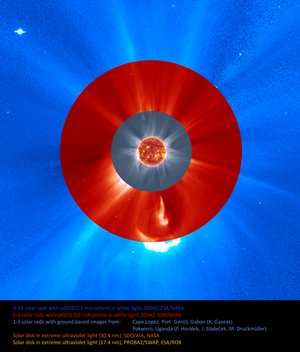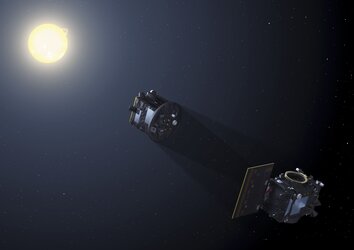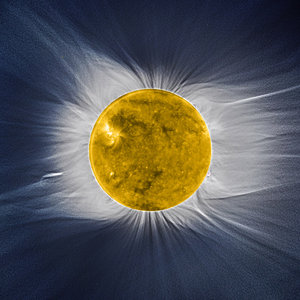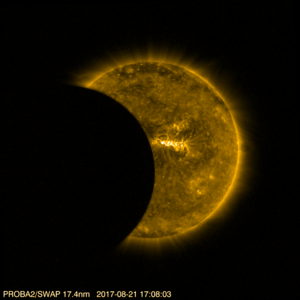Accept all cookies Accept only essential cookies See our Cookie Notice

About ESA
The European Space Agency (ESA) is Europe’s gateway to space. Its mission is to shape the development of Europe’s space capability and ensure that investment in space continues to deliver benefits to the citizens of Europe and the world.
Highlights
ESA - United space in Europe
This is ESA ESA facts Member States & Cooperating States Funding Director General Top management For Member State Delegations European vision European Space Policy ESA & EU Space Councils Responsibility & Sustainability Annual Report Calendar of meetings Corporate newsEstablishments & sites
ESA Headquarters ESA ESTEC ESA ESOC ESA ESRIN ESA EAC ESA ESAC Europe's Spaceport ESA ESEC ESA ECSAT Brussels Office Washington OfficeWorking with ESA
Business with ESA ESA Commercialisation Gateway Law at ESA Careers Cyber resilience at ESA IT at ESA Newsroom Partnerships Merchandising Licence Education Open Space Innovation Platform Integrity and Reporting Administrative Tribunal Health and SafetyMore about ESA
History ESA Historical Archives Exhibitions Publications Art & Culture ESA Merchandise Kids Diversity ESA Brand Centre ESA ChampionsLatest
Space in Member States
Find out more about space activities in our 23 Member States, and understand how ESA works together with their national agencies, institutions and organisations.
Science & Exploration
Exploring our Solar System and unlocking the secrets of the Universe
Go to topicAstronauts
Missions
Juice Euclid Webb Solar Orbiter BepiColombo Gaia ExoMars Cheops Exoplanet missions More missionsActivities
International Space Station Orion service module Gateway Concordia Caves & Pangaea BenefitsLatest
Space Safety
Protecting life and infrastructure on Earth and in orbit
Go to topicAsteroids
Asteroids and Planetary Defence Asteroid danger explained Flyeye telescope: asteroid detection Hera mission: asteroid deflection Near-Earth Object Coordination CentreSpace junk
About space debris Space debris by the numbers Space Environment Report In space refuelling, refurbishing and removingSafety from space
Clean Space ecodesign Zero Debris Technologies Space for Earth Supporting Sustainable DevelopmentLatest
Applications
Using space to benefit citizens and meet future challenges on Earth
Go to topicObserving the Earth
Observing the Earth Future EO Copernicus Meteorology Space for our climate Satellite missionsCommercialisation
ESA Commercialisation Gateway Open Space Innovation Platform Business Incubation ESA Space SolutionsLatest
Enabling & Support
Making space accessible and developing the technologies for the future
Go to topicBuilding missions
Space Engineering and Technology Test centre Laboratories Concurrent Design Facility Preparing for the future Shaping the Future Discovery and Preparation Advanced Concepts TeamSpace transportation
Space Transportation Ariane Vega Space Rider Future space transportation Boost! Europe's Spaceport Launches from Europe's Spaceport from 2012Latest
Multiwavelength solar eclipse activity
Thank you for liking
You have already liked this page, you can only like it once!
This animated gallery depicts solar activity during the day of the solar eclipse on 3 November 2013, as it was observed from three separate observing locations and across various different wavelengths.
A total solar eclipse provides ground-based observers with the rare opportunity of seeing the solar corona, but the terrestrial atmosphere blocks a large portion of the electromagnetic spectrum. Observatories in orbit can cover this gap, enabling continuous monitoring of the solar disc in a variety of wavelengths. Extreme-ultraviolet light is covered by the Royal Observatory of Belgium’s SWAP instrument aboard ESA’s Proba-2 minisatellite and the AIA and HMI instruments aboard the Solar Dynamics Observatory. Ground-based images in white light from Cape Lopez at Port Gentil in Gabon show the solar activity of the lower corona during totality, in a composite image captured from the beginning until the end of the eclipse, about three hours in length.
The satellite images in extreme-ultraviolet wavelengths used in this animation were acquired approximately every 30 minutes and span the entire day of 3 November 2013. The solar corona was visible during the 65 seconds of totality in Gabon at 13:50 GMT, while Proba-2’s SWAP captured images of a partial eclipse several times because the satellite is following a Sun-synchronous orbit that is not in perfect alignment with the Sun and Moon.
-
CREDIT
Kosmas Gazeas (University of Athens, Greece, kgaze@phys.uoa.gr), Proba-2 (ESA/ROB), SDO (NASA) -
LICENCE
ESA Standard Licence
-
Close-up
-
-
-
-

Multiwavelength solar view

Proba-3 satellites form artificial eclipse

Solar eclipse corona

Proba-2 partial eclipse















 Germany
Germany
 Austria
Austria
 Belgium
Belgium
 Denmark
Denmark
 Spain
Spain
 Estonia
Estonia
 Finland
Finland
 France
France
 Greece
Greece
 Hungary
Hungary
 Ireland
Ireland
 Italy
Italy
 Luxembourg
Luxembourg
 Norway
Norway
 The Netherlands
The Netherlands
 Poland
Poland
 Portugal
Portugal
 Czechia
Czechia
 Romania
Romania
 United Kingdom
United Kingdom
 Slovenia
Slovenia
 Sweden
Sweden
 Switzerland
Switzerland

























